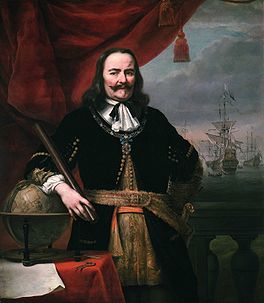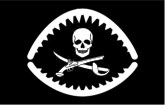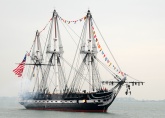-
 On this day 26 August - The Battle of Plymouth
On this day 26 August - The Battle of Plymouth
The Battle of Plymouth was a naval battle in the First Anglo-Dutch War. It took place on 26 August 1652 (New Style, 16 August Old Style) and was a short battle, but had the unexpected outcome of a Dutch victory over England. General-at-Sea George Ayscue of the Commonwealth of England attacked an outward bound convoy of the Dutch Republic commanded by Vice-Commodore Michiel de Ruyter. The two commanders had been personal friends before the war. The Dutch were able to force Ayscue to break off the engagement, and the Dutch convoy sailed safely to the Atlantic while Ayscue sailed to Plymouth for repairs.
On 29 July De Ruyter was appointed Vice-Commodore, an originally Dutch creation between Captain and Rear-Admiral, with the confederate Dutch fleet and shortly after took over command, in the absence of Vice-Admiral Witte de With, of a squadron assembling in the Wielingen, off the coast of Zealand, to escort a large convoy. Around the 10th of August, De Ruyter took sea before the merchantmen had arrived, to seek out an English fleet of forty ships, commanded by Ayscue, which he knew had left The Downs on 29 July. De Ruyter's squadron at that moment consisted of 23 warships and six fireships, with a total of about 600 cannon and 1700 men. As De Ruyter reported to the States-General of the Netherlands, most crews were badly trained, many ships poorly maintained and he had just two months of supplies. Nevertheless he preferred to give battle early without the burden of having to protect the convoy.
Reaching the English Channel, he soon discovered that Ayscue was not interested in fighting the Dutch squadron, but avoided it in the hope of intercepting the convoy. To lure Ayscue out De Ruyter started to cruise off the coast of Sussex, causing an uproar with the local population, but Ayscue, despite his fleet having grown to 42 ships, did not react. Meanwhile De Ruyter had lost two ships, sent out to escort a single incoming merchantman to the mouth of the Somme river, when they collided, sinking one, the Sint Nicolaes, and severely damaging the other, Gelderlandt.
On 21 August De Ruyter at last did rendezvous with the convoy of sixty merchantmen off Gravelines in the southern North Sea. He was pleased to notice that it brought ten warships with it, bringing his total to 31. On 23 August De Ruyter re-entered the Channel near Calais. His instructions were to escort the convoy to the Atlantic; there most ships would head for the Mediterranean together with their ten escorts, while the original squadron would have to wait to pick-up merchantmen coming from the West Indies and transporting silver. Ayscue's fleet had then grown to 47 vessels: 38 men-of-war, among which armed merchantmen; five fireships, and four smaller vessels.
On 25 August, the English spotted the Dutch fleet off the coast of Plymouth, and took sea. Ayscue the next day, off the coast of Brittany, around 13:30 attempted a direct attack from the north against the convoy, having the weather gauge. He hoped it would scatter, allowing him to capture some very profitable prizes, but De Ruyter unexpectedly separated his naval squadron and changed course in order to meet Ayscue’s attack, shielding the merchantmen. Ayscue’s ships were on average more heavily armed, but extremely disorganised because the fastest vessels, among them Ayscue's flagship the George and the Vanguard of his vice-admiral William Haddock, had broken formation in the hope of catching, during a running battle, straggling Dutch merchantmen; they were now unable to form a line of battle and fully exploit their advantage in firepower over the Dutch. The Dutch squadron however, sailing to the northwest, was in a rough defensive leeward line formation, with the Frisian acting Rear-Admiral Joris Pieterszoon van den Broeck commanding the van, De Ruyter himself commanding the centre and Hollandic Rear-Admiral Jan Aertsen Verhoeff commanding the rear. Around 16:00 the Dutch fleet and seven forward English vessels met and almost immediately passed through each other — both sides afterwards claiming to have "broken the enemy line". Having thus gained the weather gauge the Dutch at once exploited this by turning and attacking from the north. They would describe this as a second breaking of the line but probably the battle soon degenerated into a confusing mêlée. With their best ships now surrounded by the mass of Dutch vessels and bearing the brunt of the fight, the slower remainder of the English fleet, largely consisting of poorly trained hired merchantmen, was, reaching the scene of the battle, not overly zealous to get involved. Their numerical superiority thus also gained the English little.
The largest Dutch vessel, the Dutch East India Company warship Vogelstruys, by Dutch standards heavily armed with a lower tier of 18-pounders, got separated from the rest of the Dutch fleet and was attacked by three English ships at once and boarded. Her crew was close to surrendering when her captain, the Frisian Douwe Aukes, threatened to blow her up first. Faced with this alternative the crew rallied, drove off the English boarding team and put up such a fight that the English vessels, much damaged and two even in a sinking condition, broke off the attack. The Dutch employed their favourite tactic of disabling enemy vessels by firing at their masts and rigging with chain shot; at the end of the afternoon Ayscue, feeling rather unsupported, decided to break off the unsuccessful engagement and to retreat to Plymouth to repair his ships before any became so damaged they would be captured. The Bonadventure could only disengage after an English fireship, the Charity commanded by Captain Simon Orton, set itself alight and frightened off the attacking Dutch vessels. De Ruyter in his journal concluded:
If our fireships had been with us — they remained leeward — we would with the help of God have routed the enemy; but praised be God who has blessed us in that our enemy fled by himself, though 45 sails strong and of great force
Neither side lost a warship, but both sides suffered heavy casualties among their crews. The Dutch had about sixty dead and fifty wounded. The reports on the English losses differ: one set the number as high as seven hundred casualties including the wounded (most from the failed attack on the Vogelstruys), another mentioned 91 dead, among them Ayscue's flag captain Thomas Lisle. Rear-Admiral Michael Pack had a leg amputated and shortly afterwards died of the complications. The English spent one fireship.
De Ruyter pursued the English fleet after its retreat. On the morning of the next day both forces transpired to be still close to each other and De Ruyter hoped by aggressively pursuing to capture some stragglers; several English ships were in tow and might well be abandoned if he pressed hard enough. However Ayscue, fearing for his reputation, on 27 August convinced the English council of war to again give battle if necessary and brought his entire force safely back to Plymouth on 28 August. De Ruyter then sent two warships to escort the merchant fleet through the Channel to the Atlantic. For a while he considered trying to attack the enemy fleet at anchorage in Plymouth Sound, but in the end decided against it as he did not have the weather gauge. Then hearing that General-at-Sea Robert Blake was sailing to the west with a superior force of 72, he chose to withdraw to the west and kept assembling incoming West Indiesships throughout September. On 25 September Blake had reached Portland and sent out a squadron of eighteen sail commanded by William Penn to intercept De Ruyter, but the latter escaped east along the French coast while Blake had been forced by a storm to seek shelter in Torbay. De Ruyter escorted twelve merchantmen safely to Calais on 2 October when his supplies had nearly run out. In October nine or ten of the Dutch ships, among them De Ruyter's flagship the Kleine Neptunis, then had to return to port for repairs, probably because of insufficiently repaired damage from the battle.
The English ships had expected to easily defeat the Dutch in a set battle because of their superiority in armament and numbers. While the failure came as an unpleasant surprise to the English, the Dutch populace rejoiced in the tactical draw, hailing De Ruyter, who had not been well known among the larger public, as a naval hero. The English accused some merchantmen captains of cowardice. Ayscue was blamed for poor leadership and organisation: his attempt to present the encounter as a victory failed to convince. He lost command after this battle, though probably for political reasons: he had known royalist sympathies. Less important was his emphasis on capturing prizes while avoiding battle; in the first year of the war this was a very common attitude, the English mainly seeing the conflict as one large privateering campaign, allowing them to gain riches at the expense of the Dutch; only with the Battle of the Gabbard would they really try to establish naval dominion.
This victory was very important to the naval career of De Ruyter: it was the first time he commanded an independent force as a fleet commander. Before, he only had had subcommand of a flotilla aiding Portugal in 1641. As a result of the battle he acquired the nickname The Sea Lion. Before he could return home, De Ruyter was first involved in the Battle of the Kentish Knock but arriving in Middelburg he was received by the States of Zealand and rewarded with a golden honorary chain of a hundred Flemish pounds for both battles because he in the first had shown "masculine courage" and in the second "courageous prudence" — having convinced Witte de With to a timely retreat.
George Ayscue:

Michiel de Ruyter:

The text of today's event is taken directly from http://en.wikipedia.org/wiki/Battle_of_Plymouth
-

IMSMC: Shortly after this (and another English defeat) would be introduced the _Instructions for the Fleet in Sailing_ and _Instructions for the Fleet in Fighting_, which would come to dominate naval thinking for the next century-and-change.
-

On 26 August 1839, the U.S. Navy Brig USS Washington seized the Spanish Slave Ship Amistad near Montauk Point, New York. The Africans aboard were held on murder charges due to their prior seizure of the ship in July. The case went to the Supreme Court in January 1841, and former President John Quincy Adams argued the defendants' case. Adams defended the right of the accused to fight to regain their freedom. The Supreme Court decided in favor of the Africans, and 35 of them were returned to their homeland. The others died at sea or in prison while awaiting trial. Read more about the Ship Amistad on the Navy Department Library’s Online Reading Room:
http://www.history.navy.mil/faqs/faq55-1.htm --
Read more about President John Quincy Adams on
The White House Website:
http://www.whitehouse.gov/about/pres...ohnquincyadams --
#USNavy | #NavyHistoryNews | #WhiteHouse
-

On 26 August 1775 -- Rhode Island delegates press the Continental Congress for creation of a Continental Navy to protect the colonies due to the harassment of shipping by the British. The resolve would lead to the birth of the Continental Navy.
Learn more about the Continental Congress on The Library of Congress website: http://memory.loc.gov/ammem/collections/continental/
-

On 26 August 1843, the day after the U.S. Navy Steam Frigate Missouri became the first steam-powered Navy ship to complete a Trans-Atlantic crossing, she suffered a accidental onboard fire, exploded and sank at Gibraltar without any loss of life.
Read more about USS Missouri:
http://www.history.navy.mil/photos/s...m/misouri1.htm --
 Posting Permissions
Posting Permissions
- You may not post new threads
- You may not post replies
- You may not post attachments
- You may not edit your posts
-
Forum Rules






 Reply With Quote
Reply With Quote




Bookmarks